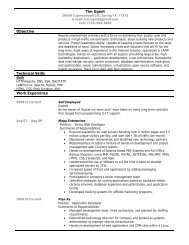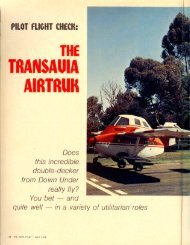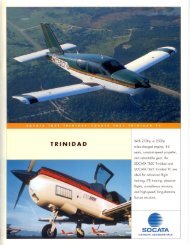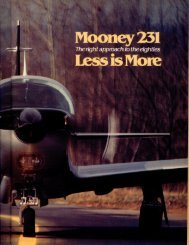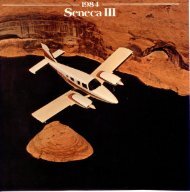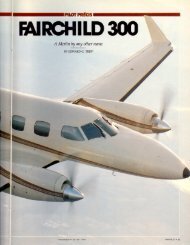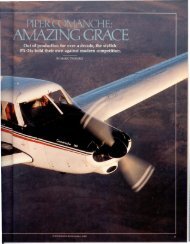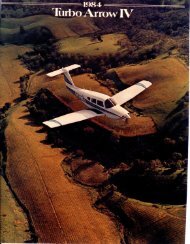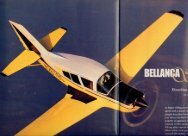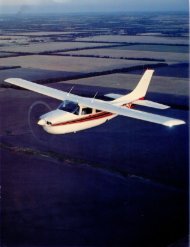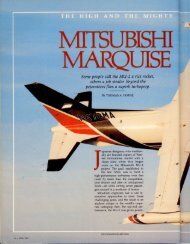PlIDI" PRa!CIS Partenavia enters the turbine arena. - Aero ...
PlIDI" PRa!CIS Partenavia enters the turbine arena. - Aero ...
PlIDI" PRa!CIS Partenavia enters the turbine arena. - Aero ...
You also want an ePaper? Increase the reach of your titles
YUMPU automatically turns print PDFs into web optimized ePapers that Google loves.
PlIDI" <strong>PRa</strong>!<strong>CIS</strong><strong>Partenavia</strong><strong>enters</strong> <strong>the</strong> <strong>turbine</strong> <strong>arena</strong>.BYTHOMAS A. HORNETHE has <strong>Partenavia</strong> grown. line To <strong>the</strong> of P-68C light twin-engine Victor (May airplanes 1981 Pilot,p. 92), <strong>the</strong> turbocharged P-68C-TC Victor (May 1983Pilot, p. 74) and <strong>the</strong> plexiglass-nosed P-68 Observer (September1983 Pilot, p. 38), add <strong>the</strong> AP-68TP-300 Spartacus.The Spartacus is <strong>Partenavia</strong>'s entry in <strong>the</strong> turboprop market.It is equipped with two Allison engines, flat-rated to328 shaft horsepower.Although its power does not match that of some heavierturboprops, and <strong>the</strong> Spartacus is unpressurized, <strong>the</strong> airplanehas some attractive virtues.Among <strong>the</strong>m is its simplicity-a feature it shares with<strong>the</strong> rest of <strong>the</strong> <strong>Partenavia</strong> twins. The landing gear is fixed,and <strong>the</strong> high wing design contributes to <strong>the</strong> cabin's boxyroominess. As an offspring of <strong>the</strong> P-68, <strong>the</strong> Spartacus retains<strong>the</strong> same interior dimensions that have made itsPHOTOGRAPHYBY ART DAVIS
68· FEBRUARY 1985If SPARfACUS
predecessors popular as cargo-haulers and photogrammetriccamera platforms.The Spartacus has three doors: one for <strong>the</strong> pilots, onethat admits passengers to <strong>the</strong> main cabin and a rear doorthat gives access to <strong>the</strong> rearmost seats and baggage compartment.This is an improvement over previous Spartacusmodels, which came with a single door, located at midcabinon <strong>the</strong> left side.Ano<strong>the</strong>r change is <strong>the</strong> Spartacus's horizontal stabilizerand elevator. The o<strong>the</strong>r <strong>Partenavia</strong> twins use a stabilator.High-speed flutter tests of stabilator-equipped Spartacusesresulted in <strong>the</strong> crashes of two prototypes. In each case,flutter-caused by destructive harmonics set up by <strong>the</strong>interaction of engine and airframe vibrations-resulted instabilator failure. The traditional stabilizer-and-elevator arrangementwas found to be stronger.The Spartacus was certificated in Italy in May 1984.American certification soon followed, and <strong>the</strong> airplanemade one of its first big showings in this country at <strong>the</strong>AOPA Industry Exhibit in Nashville, Tennessee, last October.Shortly <strong>the</strong>reafter, American distributor Mira Slovakvisited AOPA headquarters at <strong>the</strong> Frederick (Maryland)Municipal Airport and gave members of Pilot's staff a brieflook at <strong>the</strong> new airplane.Slovak explained that <strong>the</strong> Spartacus is designed for individualsand companies wanting <strong>the</strong> reliability and redundancyof a turboprop twin without <strong>the</strong> million-dollar-plusprice tag. The Spartacus's base price is $608,500, FAF Naples,Italy. Delivery charges to <strong>the</strong> United States are anadditional $9,000: <strong>the</strong> bare bones price-$617,500.I-SPRS, Slovak's demonstrator, was loaded with optionsincluding radar, radar altimeter, full ice-protection equipment,a brace of King avionics worth $31,000 and a plush"VIP" interior. Its price is $757,979.Flying <strong>the</strong> Spartacus is a delight. Takeoff acceleration isimpressive, and, with partial flap extension and a partialload, <strong>the</strong> airplane will lift off within a few seconds of brakerelease. The controls have a crispness that is similar to asingle ra<strong>the</strong>r than a <strong>turbine</strong> twin. It was relatively easy tomaintain a tight formation with our photography airplane-aCessna 172RG-even though <strong>the</strong> Spartacus wasin slow flight.Part of our demonstration flight included short-fieldtakeoffs and landings. The airplane flight manual indicatesthat <strong>the</strong> Spartacus will land and stop within 843 feet, usingreverse thrust. But Slovak was able to prove that <strong>the</strong> airplanecould land in a far shorter distance."You can land it in about 500 feet, but it's pretty hardon <strong>the</strong> airplane," said SlovakThe combination of <strong>the</strong> Spartacus's STOL-like features,its <strong>turbine</strong> power, <strong>the</strong> fixed gear, high-wing design andloading configurations should prove attractive to those flyinglarge or heavy loads to unimproved airstrips at highdensity altitudes.The airplane still is undergoing refinement and development.Accelerate/stop distance information is "to be issuedlater," according to <strong>the</strong> flight manual. The electrical system,which normally operates with its starter-generators inparallel, soon may be changed to <strong>the</strong> American standardbothgenerators powering <strong>the</strong> system in series. An avionicsAOPA PILOT • 69
continued\master switch also is 9ue to be standard on <strong>the</strong> Spartacus.Spartacus's certification for flight into known icing conditionsis scneduled for early this year. The last series oftests, conducted in West Germany, were drawing to a closein December 1984.<strong>Partenavia</strong> plans to introduce two more light twins in1985, both based on <strong>the</strong> Spartacus-<strong>the</strong> Spartacus RG and<strong>the</strong> Pulsar. The RG's retractable gear will add approximately$45,000 to <strong>the</strong> Spartacus's base price and will alter<strong>the</strong> airplane's shape-Mitsubishi MU-2-style fuselage podswill be used to house <strong>the</strong> main landing gear. The SpartacusRG first flew on June 1, 1984.The Pulsar will be a pressurized, retractable-gear modelwith a new wing design and wing-tip fuel tanks. A finaldecision concerning <strong>the</strong> Pulsar's engines has not yet beenmade. They ei<strong>the</strong>r will be <strong>the</strong> 440-shp version of <strong>the</strong> Allison250 engines used in <strong>the</strong> Spartacus, or Lycoming enginesof comparable power.So far, <strong>Partenavia</strong>s have enjoyed a limited success in thiscountry. Sales of P-68Cs, P-68C-TCs and Observers haveamounted to 29, 14 and two airplanes, respectively. Nowthat <strong>Partenavia</strong> (and its subsidizers, <strong>the</strong> Italian governmentand Aeritalia) has upped <strong>the</strong> ante and stepped into <strong>the</strong>more lucrative <strong>turbine</strong> market, it will be interesting to seewhe<strong>the</strong>r it can secure a more prominent beachhead onAmerican shores. 0IfSPARrACUS170· FEBRUARY 1985
Powerplants<strong>Partenavia</strong>• Spartacus,AP-68TP-300I-SPRSBase price: $608,500Price as tested: $757,979AOPA Pilot Operations/Equipment Category':All-wea<strong>the</strong>r: $649,000 to $760,000SpecificationsTwo Detroit Diesel Allison250-B I 7C turboprop, 328 shpTBO, hot section 3,300 hrLengthHeightWingspanWing areaWing loadingPower loadingSeatsCabin length (including baggagecompartment)Cabin widthCabin heightEmpty weight (basic airplane)Empty weight (I-SPRS)Max zero fuel weightMax ramp weightPropeller Hartzell HC-B3TF-7 A/T 10173F-2IR, 80-in dia, three-blade, fullfea<strong>the</strong>ring,reversible pitch32 ft 6 in12 ft39 ft 4 inMax takeoffweightUseful load (basic airplane)Useful load (I-SPRS)Payload w /full fuel (basic airplane)Payload w /full fuel (I-SPRS)Max landingFuel capacityOil capacityweight(ea engine)Oil tank capacity (ea engine)BaggagecapacityPerformanceTakeoff distance, ground roll 760 ftTakeoff distance over 50-ft obst 1,267 ftMax demonstrated crosswind component 15 ktRate of climb 2,057 fpmSingle-engine rate of climb (sea level) 520 fpmMax cruise speed (12,000 ft) 209 KTAS200.2 I sq ft Cruise speed/range w /45-min rsv28.6 Ib/sq ft (fuel consumption ea engine)8.73 Ib/hp @ Max cruise power8-9 20,000 ft205 KTAS/930 nm15 ft3 ft 7 in3 ft 11 in3,2411b3,458 Ib5,300 Ib5,7871b(276 pph/4 I gph)@ Recommended cruise power20,000 ft 199 KTAS/980 nm@ Max range power20,000 ftMax operatingaltitude5,7321b2,546 Ib2,329 Ib1,0451b828 Ib5,445 Ib224 gal (222 gal usable)6 qt9 qt220 Ib (17 cu ft)(254 pph/38 gph)170 KTAS/I,090 nm(205 pph/3 I gph)25,000 Itl.anding distance over 50-ft obst 1,405 ItLanding distance, ground roll 843 ItLimiting and Recommended AirspeedsVmc (Min control w/criticalengine inoperative)79 KIASVsse (Min intentional one-engineinoperative)90 KIASVx (Best angle 01 climb)90 KIASVy (Best rate 01 climb)Vxse (Best single-engineVyse (Best single-engineVa (Design maneuvering)Vie (Max flap extended)15 degrees35 degreesVmo (Maximumlimit speed)operatingrate 01 climb)rate 01 climb)110 KIAS90 KIAS105 KIAS150 KIAS161 KIAS119 KIAS200 KIASMmo (Max operating Mach number) 0.40 MachVr (Rotation)85 KIASVs 1 (Stall clean) 75 KIASVso (Stall in landing configuration) 65 KIASAll specificatiollsare based all mallufacturerscalculatiolls. All performallce figures arebased 011stalldard day, stalldard atmosphere, at sealevel alld gross weight, ulliess o<strong>the</strong>rwise lIoted.'Operatiolls/EquipmCllt Categories are defilledill JUlie 1984 fiJ£!, p. 108. The pricesreflect <strong>the</strong> costs for equipmellt recommelldedto operate ill <strong>the</strong> listed categories.



